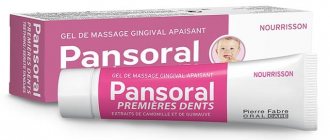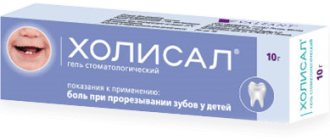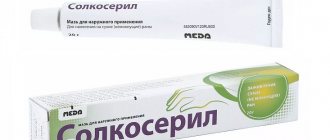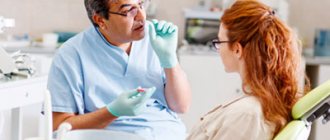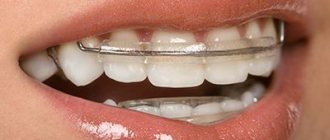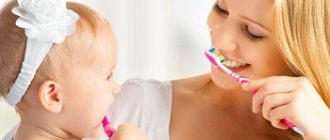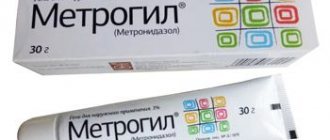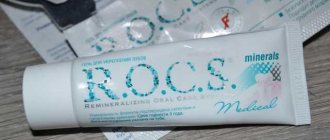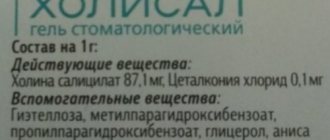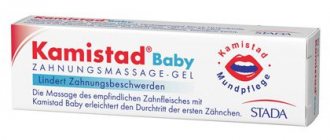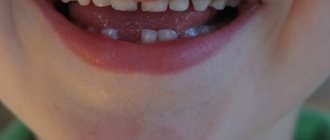Author of the article:
Soldatova Lyudmila Nikolaevna
Candidate of Medical Sciences, Professor of the Department of Clinical Dentistry of the St. Petersburg Medical and Social Institute, Chief Physician of the Alfa-Dent Dental Clinic, St. Petersburg
The first tooth is not only a significant event for mom and dad, but also considerable torment for the baby. After all, the appearance of the first incisors is accompanied by very painful sensations that torment both babies and their parents.
Special pain-relieving gels for babies’ tender gums will help relieve discomfort from teething, calm your baby and ensure sound sleep for yourself and him. Let's figure out how to use and choose these remedies so as not to harm the baby and relieve the unpleasant symptoms of growing up.
Content:
- Active substance
- Indications for use
- How to use it correctly
- Benefits of the medicine
- Contraindications
In the treatment of many dental diseases, doctors use local anti-inflammatory drugs.
They have an impact directly on the source of inflammation, thanks to which the doctor quickly gets positive results. The drug Asepta, made from the waste product of bees, is in particular demand in dental practice. It is produced by a Russian pharmaceutical company. In pharmacies, the product can be purchased in the form of a gel located inside a plastic tube. The kit includes a small spatula applicator for convenient use of the medicine.
Active substance
The official instructions indicate that the gum base contains only one active ingredient - propolis. As is known, it has antimicrobial, anti-inflammatory, analgesic and antipruritic properties, and exhibits pronounced activity against gram-positive bacteria.
The composition with propolis accelerates regeneration, promotes rapid epithelization of wound surfaces in the mouth, and supports the normal course of metabolic processes. Studies have shown that it reduces gum inflammation by 31%.
The medicinal effect of the beekeeping product is explained by the presence in it of a number of biologically active organic compounds. They have a direct effect on oral tissues and pathogenic bacteria, thereby ensuring positive results in the treatment of a wide variety of dental ailments.
Main properties of propolis:
- Significantly reduces or completely eliminates pain and discomfort in the gums. But you need to understand that pain relief is not an easy task. With severe pain symptoms, it will not be possible to do without analgesics. The analgesic effect of Asept gel manifests itself gradually, so it is important not to forget to re-treat the gums in a timely manner.
- Fights inflammation, provides excellent prevention of purulent and necrotic processes. Reduces the severity of swelling, removes redness, normalizes the temperature in the damaged area and helps restore full blood circulation.
- Destroys pathogenic microflora. Doctors refer to the “creation of bees” as a natural antibiotic. It does not disturb the natural microflora of the oral cavity and does not cause undesirable consequences.
- Accelerates wound healing. With regular use of the medicine, wounds and ulcers heal much faster. Inflammation subsides already on the second or third day of treatment.
Taken together, these properties make propolis an important assistant for dentists. If you have been prescribed this drug, listen to your doctor’s opinion - Asepta copes with a wide variety of lesions.
Clinical researches
According to the results of clinical use of the Asepta series of products: in the majority of patients examined, the level of hygiene according to the Green Vermillion index was satisfactory.
Already at the first follow-up examination (1-2 days) after using the Asepta line products, a decrease in complaints of discomfort is noted. On the 7th day, complaints of gum bleeding persisted in a small proportion of patients, but upon examination, all of them noted a decrease in hyperemia and swelling of the gums, but persistence of bleeding upon probing. On day 14, 2 patients continued to complain of bleeding gums when brushing their teeth; upon examination, a significant decrease in hyperemia and swelling of the gums was noted.
Improved dynamics of indicators allows us to recommend the Asepta line of products for the local treatment of inflammatory periodontal diseases.
Sources:
- Clinical experience in using the Asepta series of products Fuchs Elena Ivanovna Assistant of the Department of Therapeutic and Pediatric Dentistry State Budgetary Educational Institution of Higher Professional Education Ryazan State Medical University named after Academician I.P. Pavlova of the Ministry of Health and Social Development of the Russian Federation (GBOU VPO RyazSMU Ministry of Health and Social Development of Russia)
- The role of anti-inflammatory rinse in the treatment of periodontal diseases (L.Yu. Orekhova, A.A. Leontyev, S.B. Ulitovsky) L.Yu. OREKHOVA, Doctor of Medical Sciences, Prof., Head of Department; A.A. LEONTIEV, dentist; S.B. ULITOVSKY, Doctor of Medical Sciences, Prof. Department of Therapeutic Dentistry of St. Petersburg State Medical University named after. acad. I. P. Pavlova
- The effectiveness of the use of Asepta balm in the treatment of patients with inflammatory periodontal diseases (Doctor of Medical Sciences, Professor Elovikova T.M., Department of Therapeutic Dentistry, USMU. Yekaterinburg) Doctor of Medical Sciences, Professor Elovikova T.M. Department of Therapeutic Dentistry, USMU. Ekaterinburg
- The effectiveness of the use of Asept “adhesive balm” and Asept “gel with propolis” in the treatment of chronic generalized periodontitis and gingivitis in the acute stage (Municipal Dental Clinic No. 4, Bryansk, Kaminskaya T. M. Head of the therapeutic department Kaminskaya Tatyana Mikhailovna MUZ City Dental Clinic No. 4, Bryansk
Indications for use
Dentists recommend using the medication for:
- Gingivitis is inflammation of the gums. It manifests itself as swelling, pain, redness, and bad breath. The product blocks the further spread of inflammation, heals tissues and accelerates their healing. It can be used as monotherapy only at the initial stage of gingivitis. If the disease is advanced, the gel should act as a concomitant therapy.
- Periodontitis. A dangerous disease that causes disruption of the periodontal junction. Promotes loosening and premature tooth loss. The remedy for periodontitis is prescribed at the final stage of treatment - when the formed periodontal pockets are cleaned and treated. "Asepta" allows you to speed up recovery and shorten the patient's rehabilitation period.
- Trophic ulcers in the mouth. With this diagnosis, ulcerative lesions that are painful to the touch are formed on the mucous membranes. In the absence of timely treatment, the area of damaged tissue increases, and regional lymph nodes become inflamed. The medication helps at any stage of the ulcerative process. They must be treated according to the scheme specified by the doctor.
- Stomatitis (except for aphthous form). A pathology in which the mucous membranes of the mouth become inflamed. First, small inflamed ulcers appear, which gradually increase in size. It is necessary to start treating them as early as possible, then the abnormal process will not have time to spread widely. “Asepta” for stomatitis should be combined with antiviral drugs.
- Mechanical damage to the gums. Inflammation is often a consequence of dental procedures, rubbing of dentures, eating too hard foods, and the habit of gnawing on foreign objects. To prevent secondary infection and other complications, you should start using the gel composition immediately after the integrity of the mucous membrane is damaged. Then healing will take place much faster.
Since the drug is made on the basis of natural compounds and has a high safety profile, it can be used to prevent gingivitis and periodontitis if there is a tendency to these diseases.
How to use it correctly
The instructions say that the composition must be applied to the gums and affected areas of the oral mucosa in a thin layer. You can do this with your finger (be sure to wash your hands first!) or using a special applicator.
You should not eat or drink anything for half an hour after treatment. Otherwise, the medicine will not have time to work. Frequency of use: two or three times a day. The duration of the course should be from seven to fourteen days. For prevention purposes, it is recommended to use the drug two to three times a year.
ASEPTA gel for gums: instructions for use
Asept gel for gums instructions contain information that the gel should be used only after brushing your teeth, applying it in a thin layer to the affected (inflamed) surfaces of the oral mucosa and gums. Before using the gel, it is advisable to additionally dry these surfaces with a dry gauze swab (this will improve the fixation of the gel on the moist mucous membrane). After applying the gel, you should not drink water for at least 30 minutes, and do not eat or rinse your mouth for 2-3 hours after application.
The drug should be used in a course, using it 2-3 times a day for 7-14 days. Preventive courses are carried out 2-3 times a year. Before the course of prevention, it is advisable to visit a periodontist to remove dental plaque, otherwise you will not see much effect from using this remedy (24stoma.ru).
Analogs of Asept gel –
An indirect analogue of the drug can be called Cholisal DENTAL gel, which contains aprotinin. The latter is an antioxidant that stabilizes the walls of blood vessels (reduces their permeability), which leads to a reduction in swelling and symptoms of gum inflammation. The drug Cholisal Dental should also be used only to prevent exacerbation of inflammation, and not to treat active inflammation. Those. it is also used only between professional courses of anti-inflammatory therapy, which are carried out using antiseptics, antibiotics, etc.
The drug "Cholisal DENTAL":
Benefits of the medicine
In addition to affordable cost and high efficiency, the gel has other advantages:
- The soft gel texture allows it to be applied evenly and easily distributed even in hard-to-reach areas of the mouth. The product is suitable for spot treatment of fabrics.
- The neutral taste does not cause discomfort during therapeutic procedures.
- The presence of an applicator in the kit allows for processing in compliance with established aseptic requirements.
- The product has passed the necessary clinical tests, which confirmed its safety and effectiveness.
- Can be used for various dental diagnoses. It combines well with other medications.
Contraindications
The components present in the composition do not have a systemic effect on the body. In rare cases, patients develop allergic reactions during the treatment course. For this reason, Asepta is not prescribed for aphthous stomatitis, since if an allergy develops, the course of the disease worsens sharply.
An absolute contraindication to the use of the drug is individual intolerance to bee products. After all, the basis of the medicine is propolis.
As for therapy during pregnancy and lactation, it is also not recommended. But not because the medicine is dangerous for this category of patients, but because the necessary clinical studies on this issue have not yet been carried out.
It is important to understand: Although Asepta prevents the proliferation of pathogenic microflora, it does not replace standard hygiene procedures. Therefore, it is important to regularly use a toothbrush and toothpaste during treatment.
Anasep Gel
Trade name of the drug: Anasep®
Active ingredient (INN): metronidazole
Dosage form : gel
Compound:
Each gram of gel contains:
active substance: metronidazole benzoate equivalent to metronidazole – 10 mg;
excipients: chlorhexidine gluconate solution, carbomer, propylene glycol, glycerol, sodium saccharin, menthol, isopropyl alcohol, clove oil, diethanolamine, benzyl alcohol, cetomacrogol - 1000, purified water.
Description: translucent gel filled in polylaminated tubes.
Pharmacotherapeutic group : Drugs used in dentistry.
ATX code: A01AB17
Pharmacological properties
Combined antimicrobial drug for the treatment and prevention of infectious and inflammatory diseases of the oral cavity. The effect of the drug is due to the properties of the components included in its composition.
Metronidazole is biochemically reduced due to the 5-nitro group by intracellular transport proteins of anaerobic microorganisms. The reduced 5-nitro group of metronidazole interacts with the DNA of microbial cells, inhibiting the synthesis of their nucleic acids, which leads to the death of bacteria, is active against anaerobic bacteria that cause periodontal diseases: Porphyromonas gingivalis, Prevotella intermedia, Fusobacterium fusiformis, Wolinella recta, Eikenella corrodens, Borrelia vincenti , Bacteroides melaninogenicus, Selenomonas spp.
Aerobic microorganisms and facultative anaerobes are insensitive to metronidazole, but in the presence of mixed flora (aerobes and anaerobes), metronidazole exhibits synergistic action with antibiotics effective against common aerobes.
Chlorhexidine is a broad-spectrum antiseptic with a bactericidal effect. Active against vegetative forms of gram-negative and gram-positive microorganisms, as well as yeast, dermatophytes and lipophilic viruses.
Pharmacokinetics
After applying the gel, absorption is minimal. Only trace amounts of the drug are found in blood plasma.
Indications for use
Infectious and inflammatory diseases of periodontal and oral mucosa:
— acute and chronic gingivitis;
— acute and chronic periodontitis;
— juvenile periodontitis;
- periodontal disease complicated by gingivitis;
- aphthous stomatitis;
- inflammation of the oral mucosa when wearing dentures;
— post-extraction alveolitis (inflammation of the socket after tooth extraction);
- periodontitis, periodontal abscess (as part of combination therapy).
- toothache of an infectious nature;
- eliminates the causes of bad breath;
- prevents the appearance of dental plaque.
Directions for use and doses
Topically, for dental use only. The dose of gel on the gum area surrounding one tooth is a drop the size of a pea.
For adults and children over 6 years of age with gum inflammation (gingivitis), the gel is applied to the gum area 2 times a day; it is not recommended to wash off the gel. After applying the gel, you should refrain from drinking and eating for 30 minutes. The duration of treatment is on average 7-10 days.
In case of periodontitis, after removing dental deposits, periodontal pockets are treated with gel and the gel is applied to the gum area. Exposure time – 30 min. The number of procedures depends on the severity of the disease. In the future, the patient can apply the gel independently, applying the gel to the gum area 2 times a day for 7-10 days.
For aphthous stomatitis, the gel is applied to the affected area of the oral mucosa 2 times a day for 7-10 days.
To prevent exacerbations of chronic gingivitis and periodontitis, the gel is applied to the gum area 2 times a day for 7-10 days. Preventive courses of treatment are carried out 2-3 times a year.
To prevent post-extraction alveolitis after tooth extraction, the hole is treated with gel, then the gel is applied on an outpatient basis 2-3 times a day for 7-10 days.
Side effects
When the gel is applied topically, the risk of developing systemic side effects is low; sometimes the following may be observed: headache, allergic reactions (skin rash, itching, urticaria).
Contraindications
Individual intolerance to metronidazole, chlorhexidine, as well as nitroimidazole derivatives. Intolerance to any components included in the drug. Children's age up to 6 years.
Drug interactions
When applied topically in recommended doses, no systemic interaction of the gel with other drugs was detected.
special instructions
The use of the gel does not replace hygienic brushing of teeth, therefore, during the course of treatment, teeth brushing should be continued.
Pregnancy and lactation
It is not recommended to prescribe the drug to pregnant women in the first trimester of pregnancy. During lactation, the issue of stopping breastfeeding should be decided.
The drug should not be used after the expiration date and should be stored out of the reach of children.
Overdose
Cases of overdose with local use are unlikely.
Release form _
20 g polylaminated tube. 5 g sachet/tube.
Storage conditions
Store in a cool and dark place, at a temperature not exceeding +25°C.
Best before date
3 years.
Conditions for dispensing from pharmacies
Over the counter.
Manufacturer:
“ Marion Biotech Pvt. Ltd ”, India

